Krystyna Ziach
kunstinzicht.nlRubrieken
Over het werkFluid Time / Krystyna Ziach 2021-2023Krystyna Ziach’s Spaces of Sculptural Imagination, text by Christian Gattinoni, chief editor of lacritique.org 2015Space of Imagination / Krystyna Ziach, book, text by Hans Rooseboom, curator of photography at the Rijksmuseum Amsterdam, 2014Krystyna Ziach, Marged Disciplines, text by Hans Rooseboom, curator of photography at the Rijksmuseum Amsterdam, 2014Dark Street Revisited, 2013Work of Krystyna Ziach in collection of the Rijksmuseum Amsterdam, 2012Ephemeral Library 2010-2018Into the Void 2010-2017Inner Eye / Krystyna Ziach, by Joanne Dijkman, 2008Infinity & Archê/ Krystyna Ziach, book texts by Flor Bex, director of the Museum of Contemporary Art, Muhka Antwerp, 2006The Elements of Existence / Krystyna Ziach - ARCHÊ, by Cees Strauss, 1996Archê - The Ambivalence of Water and Fire / Krystyna Ziach, by Mirelle Thijsen, 1996Krystyna Ziach - Where Emotion Meets Reason, by Cees Straus, 1994A Chamber of Mirrors, text by Reinhold Misselbeck, curator of photography & new media of the Ludwig Museum, Cologne, 1994A Garden of Illusion / Krystyna Ziach, 1993, text by Iris DikOuter Space / Krystyna Ziach, text by Alexandra Noble, curator of the South Bank Centre in London,1991Melancholy / Krystyna Ziach - Drama Between Ratio and Emotion, text by Mirelle Thijsen, 1990Japan / Krystyna Ziach, by Huib Dalitz, a former director of the Foundation of Visual Arts Amsterdam, 1988Krystyna Ziach / Metamorphosis, text by Gabriel Bauret, Camera International, 1986, Paris
The endless variety of the human psyche was for the first time classified into four temperaments by the Greeks. In the 5th century BC, Hippocrates established that the health of the human mind was determined by the equilibrium between four bodily humours: blood, phlegm, yellow bile and black bile /.. / Aristotle was the first to link an exceptional talent in the arts and sciences with a melancholic character; to link genius with ‘homo melancholicus’.
Art and geometry
/.. / Geometry was the fifth liberal art and the science par excellence of the 16th century and of Dürer. “I shall take measure, number and weight as my objective”, Dürer said. And with that objective he meant the concept of art, in the sense of ratio, geometry, perspective and similarity. In fact, the winged Melancholia is its personification equipped with symbols of the profession (ladder, polyhedron, writing materials, compass and numerical square) and the attributes of melancholy (the wreath, the magical abacus and the facies nigra). Her thoughts and actions take place at a level of spatiality. For against the background of the perception of space, theoretical discoveries were made and the manual arts achieved mathematical and practical results. The typus geometria is often represented with the practical attributes of her theoretical discoveries - with a pair of compasses, a sextant, a compass etc. - and highly resembles the winged person in Melencolia I. Dürer paid tribute to mathematics, but also recognized its limits. More than half of his life he studied the art of mathematics and concluded that it would never provide the gratification of a metaphysical and religious revelation. He was certain that mathematics would not lead to Absolute Beauty. “But what beauty is. I do not know”, he wrote, being aware of his own limitations. In fact Dürer was the first Northern European artist who raised the depiction of the melancholic temperament to a fundamentally other and allegorical level./.. / Melencolia I is in fact a self-portrait of Dürer’s own frame of mind. The divine rapture of the melancholic genius was not unfamiliar to him. Dürer chiefly tried to depict the polarity, the essence of melancholy; the precarious balance between passionate productivity and complete apathy / .. / The copper engraving of 1514 is also the reflection of the late-medieval mind; troubled by apocalyptic visions, highly fascinated by astrology and in pursuit of the insubstantial: the sublime. At the same time it is the product of a hopeless struggle between endless musings, dissatisfaction and the reluctant achievement of perspectival and architectural results. Melencolia I is universal and a typical example of an abstract concept, deservingly symbolized in the human figure. The concordance between abstraction and a concrete image. In her photo works Krystyna Ziach also expresses the Supreme in terms of rational ordering, based on the rediscovery of the meaning of the Sublime in art. Like the early-Renaissance artist Dürer, she works after the exemplum, in terms of tradition and secondarily after reality. Only the traces of a research of perspective refer to this intention to equal a pictorial realism. Classical examples by Dürer, Da Vinci and Malevich are not reinterpreted in the sense of being copied, but are modified while the ideal character of the prototype is preserved. The striving for the absolute - for ‘the skeleton of eternity’ as Ernesto Sabato so aptly put it - which these great masters had in common and the passion on which it was based, are essential to Krystyna Ziach. This melancholic drama between emotion and ratio is what fascinates her, not the theoretical treatises which justified the discoveries. Like the aforementioned geniuses of art history, Krystyna Ziach is obsessed by proportions, striving on the one hand for perfect clarity, order, beauty and meticulousness, while on the other hand being drawn to irrational, subjective and phantasmagorical phenomena. In her series, for this very reason entitled Melancholy, she realized transformations of abstract scientific diagrams in images having an archetypal character. But the psychological condition of her models, shown by their facial expressions and gesticulation, is often far from melancholic. They personify tensions in an anachronistic monumental setting, filled with anatomical and geometrical attributes and relics. The works Transparant Body, Atlas of Atonomy and Human Geography together constitute a triptych. These works are based on the scientific, anatomical studies of Leonardo Da Vinci. Da Vinci also fits in with the tradition of the melancholic artist and scientist: enthralled by the furor melancholicus. Indeed in the Renaissance this character was again, in accordance with the positive classical interpretation, associated with the genius, instead of with a pathological condition. In his anatomical experiments, Leonardo attempted to capture the ‘spirit’ of a human being after death, by performing autopsy immediately after the decease of a person.In this triptych Krystyna Ziach made collages of the image of Da Vinci’s homo universalis, as well as of drawings of dissected body parts and floating foetuses. Fragments of the Renaissance genius are being used as objets trouvés. The archaic character of the work is enhanced by dabbing the collages with sepia and it seems as if traces of blood are left in a few dashes of red. Then she basically leaves her own body to the occult medical science, in the frontal pose of the homo universalis placed in a mandala. This really is the leitmotif of the series, not to be understood as an aesthetic highlight, but as the expression of a scientific, passionate striving for the absolute, the eternal. Also the execution of the lines, the perspective search for one vanishing point, is connected with this urge and is kept alive by Ziach throughout the entire series. That the works are interrelated appears from the choice of prototypes made by Ziach for the series Melancholy. Dürer, Da Vinci and Malevich are mathematicians, driven by passion, possessed by the conceptual, balancing on the edge of genius and obsessed by the intangible; divine beauty, the eternal and absolute supremacy. Black Cross of Malevich refers to the ideal form: the magical square, the religious icon of the universe. The black cross is the sum of five black squares and according to Malevich symbolizes pure feeling. The warm white background, constituted in fact by four squares, reflects nothingness. In the painted, monumental setting of the black cross, Ziach situates her model (who physically hardly differs from herself) and as an anachronistic homo universalis she carries the magical black square on her belly. Dürer’s Melencolia I is of course the prototype for Melancholy after Dürer. The forms which refer to the obsession of the Northern European artist with geometry, are represented within a cosmic black universe. The basic elements, such as the complex polyhedron, the circle, the ladder – referring to a building under construction – and the magical square with the numbers – which makes a historical association with Malevich’s magical, religious square very tempting – are the geometric and astrologic attributes of a very tense, naked Melancholia figure. Very intuitively Ziach chooses elements from Dürer’s engraving, which become essential archetypes in her vibrant visualisation of the ideal dimensions and the striving for order. The mirror, a perpetually returning and dominant element in the entire series, always refers to the introvert, narcistic nature typical of the artist. The mirror made its first appearance in Infinity from the series Japan (1987), where the mirror is essential to the culture of that country and associated with the infinite imagination of the gods. The mirror further refers to confusion, fitting in with the tradition of the melancholic character, and in the works Odalisque, The Image of Deception and Irrational Space with the tradition of the trompe-l’oeil, the illusion of space and infinity in art. The odalisque form is almost a thematic cliché in art history, but Ziach analyses the form conceptually and associates the anatomical pose with the geometrical shape of the pyramid. In Divina Proportione the magical square reappears again, now as a screaming but dignified red backdrop for the homo universalis figure who, as it were, floats on the clotted blood of Saura and has become entangled in a cosmic constellation of perspective lines. In the work Human Geography Ziach enters into a dialogue and searches for an intervention with the universal human proportions after Da Vinci. In Divina Proportione she integrates the 16th-century knowledge of a genius with the suprematist theories of Malevich, in order to strive for a contemporary moulding of the Absolute in the ideal anatomical proportions /.. / In his essay The Unknown Leonardo Da Vinci (The Writer and his Fantasies, Buenos Aires 1976), Ernesto Sabato describes the double life of Leonardo. On the one hand the eminent bohemian of the Renaissance, on the other the withdrawn thinker ‘striving to reach the Absolute, the skeleton of infinity’ in his laboratory of inventions. The passion and emotion underlying this rational striving are time and again the true source of inspiration for Krystyna Ziach. The desperate, melancholic reaching for the Absolute, which finds its expression in his anatomical and geometrical research, immensely fascinates her, as does the capacity of the melancholic to ask questions rather than to give answers. The colour inherent to the melancholic character is black. Although the series Melancholy is printed in colour, the work is mainly based on the monochromatic non-colours black and white. Sometimes the black has a dark blue glow, sometimes the white verges on the typical red of daybreak, but in fact primary red and a warm sepia hue are the only discernible colours, the sepia coloration being imbued with the atmosphere of the sketches of Leonardo Da Vinci. In Space of Imagination the research of the illusion of space is continued, in particular by again allowing mirrors to create confusion in a rational set-up. A model posing in foetal position is – by a horizontal line, the symbolic separation from the imagination - cut off from all kinds of geometrical elements above her, which in turn constitute the image of imagination. Perhaps the dream of the contemporary melancholic creates such visions, in the same way as, according to Goya at the end of the 19th century, the sleep of reason was begetting monsters. In her earlier work Calligraphy from the series Metamorphosis (1984-1985), Ziach already showed her fascination with shapes and symbols from the sciences of geometry and astrology, detached from their theoretical foundations. While Geometry from the same series could be interpreted as a kind of intuitive aura, a precursor of the research into the ideal spatial and anatomical dimensions in the series Melancholy. Krystyna Ziach may have given a photographic form to the obsession of Robert Burton, who in 1621 wrote in his book The Anatomy of Melancholy: “I write about Melancholy, by being busy to avoid Melancholy...
Translation: Hanny Keulers
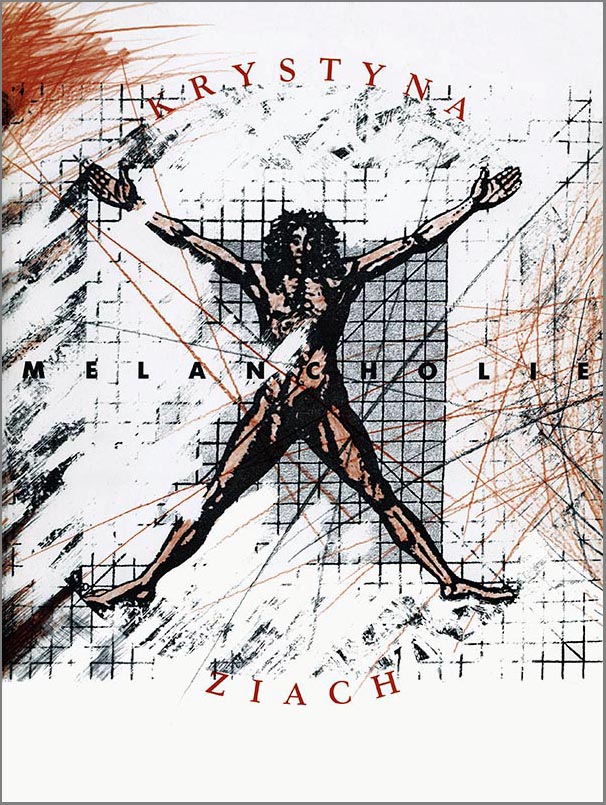
Personal catalogue, text by M. Thijsen, 24 pages, published by Magazine FOTO, 1990, NL
This catalogue has been included in different libraries a.o. : Bibliothèque Kandinsky-Centre Pompidou Paris FR, Rijksmuseum Amsterdam, Stedelijk Museum Amsterdam, RKD Netherlands Institute for Art History The Hague NL, Leiden University Library NL, and others.
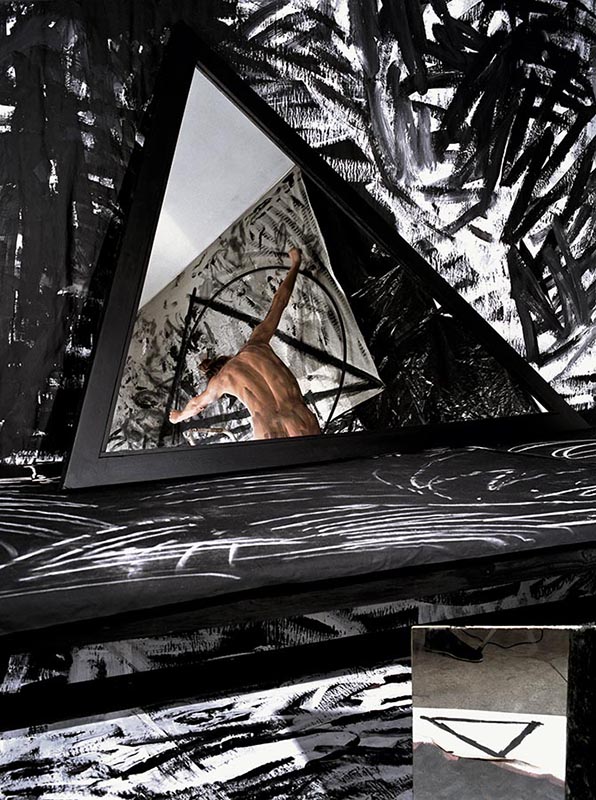
Lambda-print, 168 x 125 cmMelancholy 1989-1990
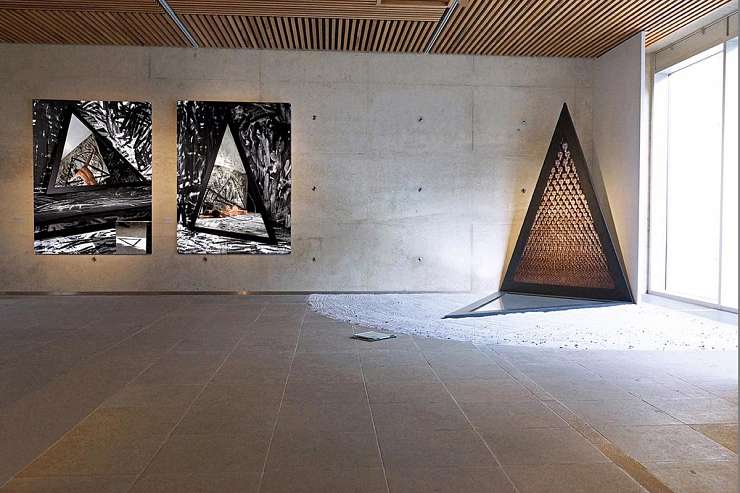
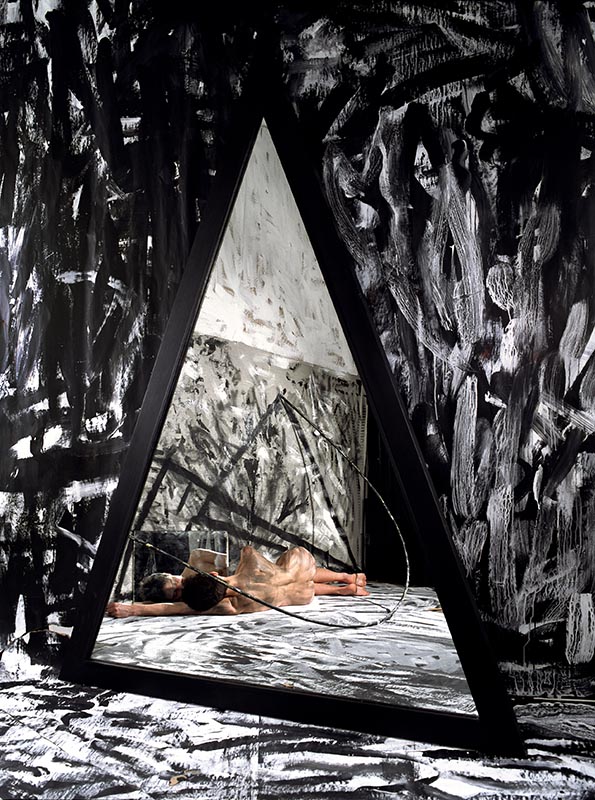
Lambda c-print, 168 x 125 cm
Melancholy 1989-1990
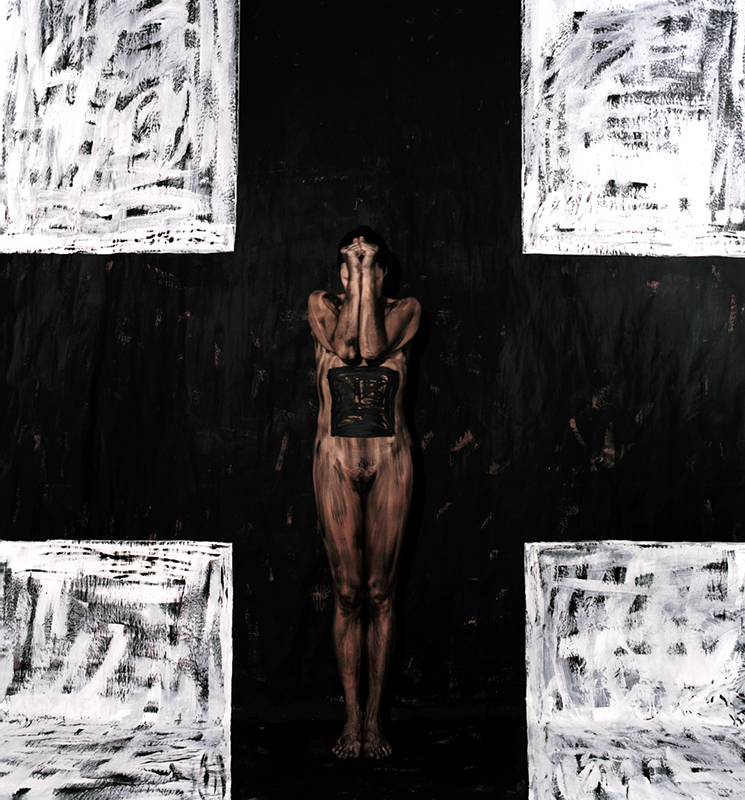
Collection Museum Het Domein, Sittard, NL